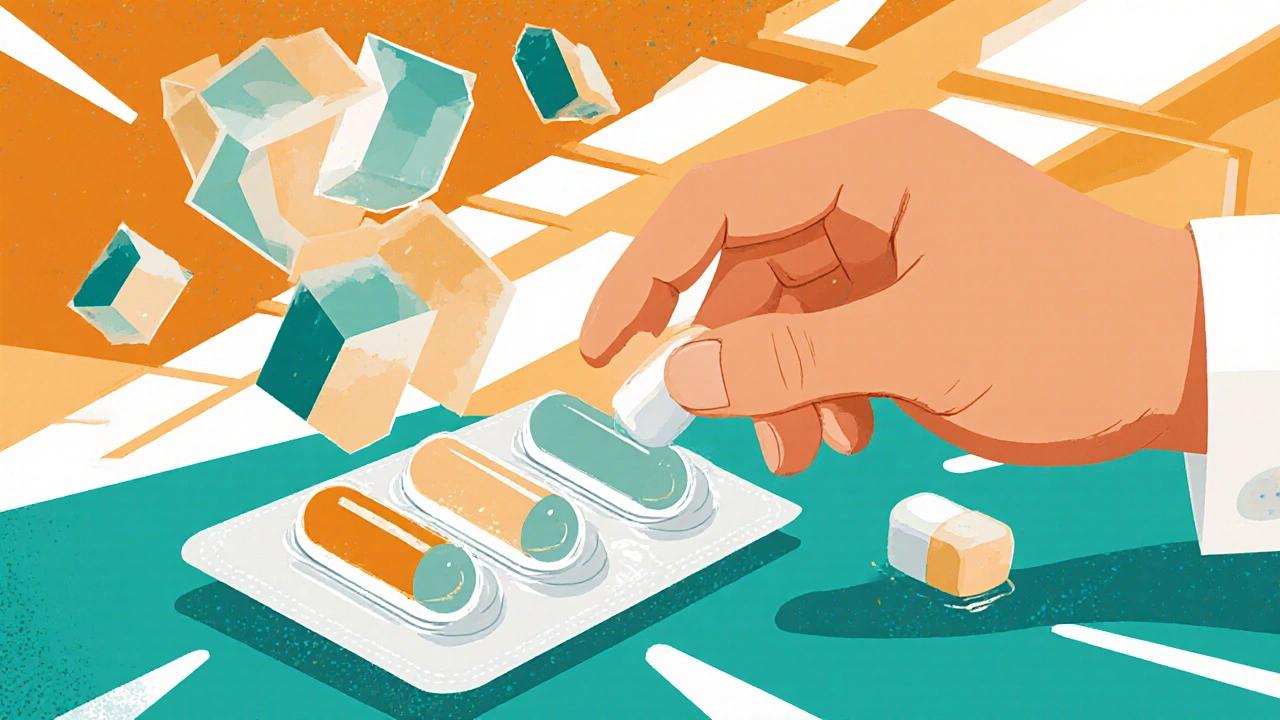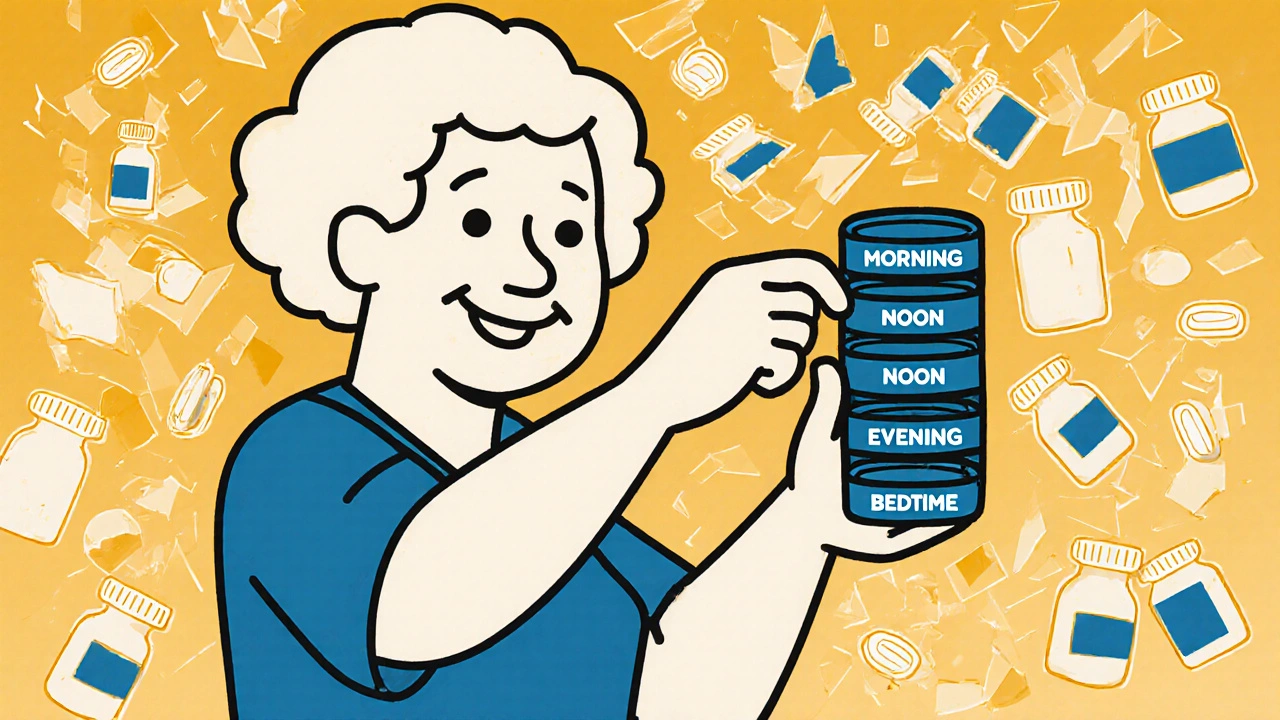SEARCH
How to Simplify Complex Medication Regimens with Fewer Daily Doses


Imagine waking up every morning to a kitchen counter covered in 10 different pill bottles. Then again at noon. Then again at dinner. And before bed. That’s not just inconvenient-it’s exhausting. And it’s exactly what millions of people, especially older adults, face every day. The truth? Medication adherence isn’t about willpower. It’s about design. When you cut down the number of times you have to take pills each day, you don’t just make life easier-you make it safer.
Why Fewer Doses Mean Better Adherence
People don’t miss doses because they’re forgetful. They miss them because the system is broken. A study from the National Institutes of Health found that 41% of medication regimens in community-dwelling older adults can be simplified with no loss in effectiveness. That’s nearly half of all patients taking too many pills at too many times. And when you reduce daily doses from seven times a day to just two or three, adherence jumps by 20-30%. It’s simple math: fewer steps = fewer chances to mess up. If you’re supposed to take five pills at 8 a.m., 12 p.m., 5 p.m., and 9 p.m., that’s four separate moments to remember. If you can combine three of those into one pill, now you only have two times to remember. That’s not just easier-it’s more human.How to Actually Simplify a Medication Schedule
Simplifying a regimen isn’t about just tossing pills together. It’s a careful process that requires checking what’s safe, what’s available, and what fits your life. Here’s how it works in real life.- Get a full list of everything you take-including over-the-counter meds, supplements, and creams. Write it down. Don’t trust your memory. Most people miss at least two or three items when they try to recall their own regimen.
- Bring it to your pharmacist or doctor. Ask: “Can any of these be combined or taken less often?” Don’t be shy. This is exactly what they’re trained for.
- Look for fixed-dose combinations. These are pills that contain two or more medications in one tablet. For example, instead of taking a blood pressure pill and a cholesterol pill separately, you might now take one pill that does both. About one-third of all successful simplifications use this method. It’s common in heart disease, HIV, and type 2 diabetes care.
- Ask about extended-release versions. Some medications come in slow-release forms that last 24 hours. If you’re taking a blood pressure pill twice a day, ask if a once-daily version exists. Many do.
- Use the Universal Medication Schedule. This isn’t a fancy tool-it’s just four times a day: morning, noon, evening, bedtime. If your meds can be grouped into these slots, you cut down confusion. Studies show this reduces dosing errors by 35% in hospitals.
- Try multi-dose packaging. These are blister packs or organizers with compartments for each time of day. Some even have alarms. For people with memory issues, this isn’t a luxury-it’s a lifeline. One caregiver on AgingCare.com said her mother went from 12 separate bottles to one organizer with four compartments. Her confusion dropped overnight.
What Works-and What Doesn’t
Not every medication can be simplified. Some need to be taken at specific times because of how the body processes them. Here’s what the data says about different approaches.| Method | Adherence Improvement | Best For | Limitations |
|---|---|---|---|
| Fixed-dose combinations | 18-25% | HIV, hypertension, type 2 diabetes | Only works if doses align; not all drugs can be combined |
| Once-daily dosing | 15-30% | Antibiotics, statins, some blood pressure meds | Not possible for drugs with short half-lives (e.g., some insulin types) |
| Medication synchronization | 22% fewer missed doses | Chronic conditions requiring monthly refills | Requires pharmacy coordination; insurance may block preferred brands |
| Multi-dose packaging | 22% higher adherence | Elderly, memory issues, complex regimens | Costs $15-$20/month extra; not always covered by insurance |
Here’s the catch: even when adherence improves, clinical outcomes don’t always follow. One study on HIV patients found that while missed doses dropped from 12% to 4%, viral load didn’t change significantly. Why? Because the patients were already doing okay. Simplification doesn’t fix broken treatment-it prevents breakdowns.

Barriers You Might Not Expect
You’d think simplifying a regimen would be easy. But reality gets messy. Insurance often won’t cover the newer, combined pills-even if they’re better. One Medicare Advantage study found 45% of patients were denied access to once-daily formulations because the insurer preferred cheaper, older versions. That’s not about safety-it’s about cost. Pharmacists report that 68% of patients misunderstand their simplified regimens. One man thought he could take his morning and evening pills together because “they’re both for my heart.” He ended up in the ER with dangerously low blood pressure. And then there’s the cost of packaging. Multi-dose organizers are great-but they’re not free. Many low-income seniors skip them because they can’t afford the extra $20 a month. Some pharmacies offer free packaging through grants, but you have to ask.Who Should Lead the Change?
This isn’t something you should do alone. The best results happen when a team works together. - Pharmacists are your secret weapon. They’re trained to spot duplication, interactions, and opportunities for simplification. Ask for a Medication Therapy Management (MTM) session-it’s covered by Medicare. - Doctors need to approve changes. But they rarely initiate them. Bring your pharmacist’s recommendations to your next visit. - Caregivers can help track what’s working. If you live alone, ask a family member to check your pill organizer once a week. Studies show that when all three-patient, pharmacist, and doctor-are involved, 50% of simplification plans get implemented. When it’s just the pharmacist? Only 12%.What’s Changing Right Now
The field is moving fast. In 2022, the FDA approved 12 new fixed-dose combinations-up 25% from two years earlier. That means more options are becoming available. Some Medicare Advantage plans are now testing smart pill dispensers. These devices connect to your phone, remind you when to take your meds, and alert your care team if you miss a dose. Early results show a 40% drop in emergency visits. The American Society of Health-System Pharmacists updated their Medication Regimen Complexity Index in 2023. Now, it doesn’t just count pills-it counts how many times you have to take them. That’s a big deal. It means doctors and pharmacists are finally measuring what matters: burden, not just volume.
Your Next Step
You don’t need to fix everything at once. Start with one thing:- Take a photo of your pill bottles right now.
- Write down every time you take each one.
- Call your pharmacist and say: “I’m trying to reduce how often I take pills. Can we look at this together?”
Frequently Asked Questions
Can I just combine my pills myself if they look similar?
No. Never mix pills unless a pharmacist or doctor tells you it’s safe. Some medications can’t be crushed or combined without losing effectiveness-or becoming dangerous. For example, mixing extended-release pills with immediate-release ones can cause a dangerous overdose. Always get professional advice first.
Will simplifying my meds lower their effectiveness?
Not if it’s done correctly. Studies show that when simplification is guided by clinical evidence-like using fixed-dose combinations or extended-release versions-therapeutic outcomes stay the same or improve. The goal isn’t to cut corners. It’s to remove unnecessary complexity that causes errors.
My insurance won’t cover the once-daily version. What can I do?
Ask your doctor to file a prior authorization request. Many insurers will approve the better option if you show it’s medically appropriate. You can also ask your pharmacist about patient assistance programs. Some drug manufacturers offer free or discounted versions to those who qualify.
Is medication synchronization worth it?
Yes-if your pharmacy offers it. Synchronization means all your prescriptions are due on the same day each month. You make one trip instead of five. It cuts refill gaps by 60% and reduces the chance of running out. Most community pharmacies now offer this for free, especially for Medicare patients.
How do I know if my regimen can be simplified?
If you take five or more medications daily, or if you take any medication more than three times a day, you’re a strong candidate. Ask your pharmacist to run a quick review using the Medication Regimen Complexity Index. It takes less than 15 minutes. Many pharmacies do this during your refill visit.
What to Do Next
If you’re managing a complex regimen, don’t wait until you miss a dose or end up in the hospital. Start today:- Make a list of every medication you take, including doses and times.
- Call your pharmacy and ask if they offer medication synchronization or multi-dose packaging.
- Book a Medication Therapy Management session with your pharmacist-Medicare covers it.
- Bring your list to your doctor and ask: “Can any of these be combined or taken less often?”